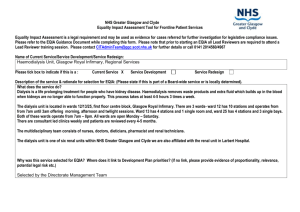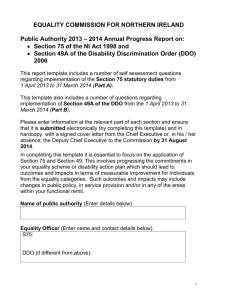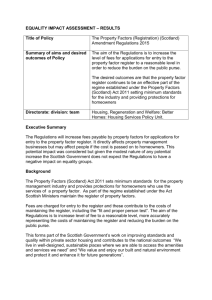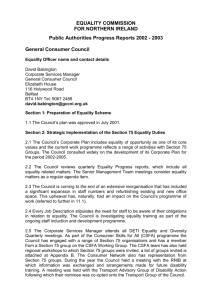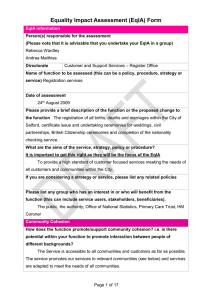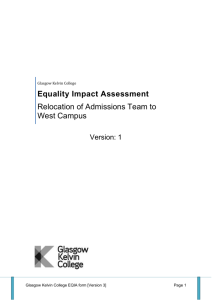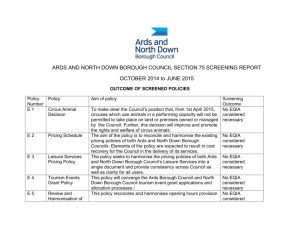Clinical Microbiology, West of Scotland Specialist Virology Centre
advertisement
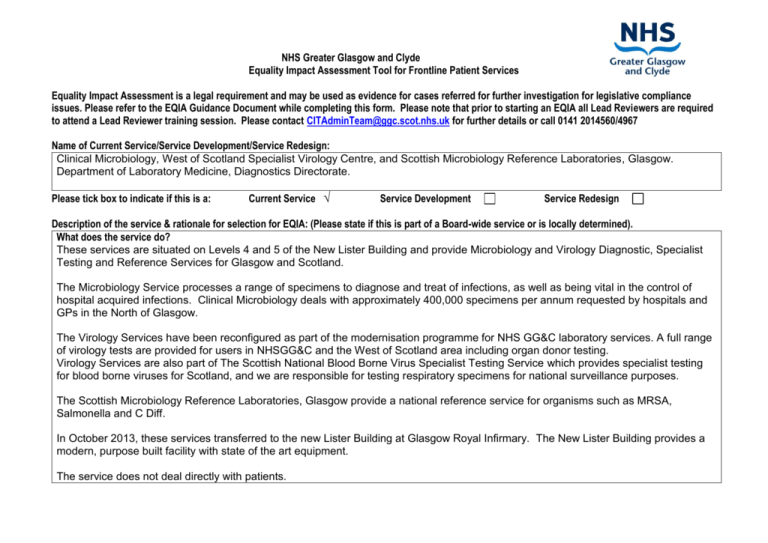
NHS Greater Glasgow and Clyde Equality Impact Assessment Tool for Frontline Patient Services Equality Impact Assessment is a legal requirement and may be used as evidence for cases referred for further investigation for legislative compliance issues. Please refer to the EQIA Guidance Document while completing this form. Please note that prior to starting an EQIA all Lead Reviewers are required to attend a Lead Reviewer training session. Please contact CITAdminTeam@ggc.scot.nhs.uk for further details or call 0141 2014560/4967 Name of Current Service/Service Development/Service Redesign: Clinical Microbiology, West of Scotland Specialist Virology Centre, and Scottish Microbiology Reference Laboratories, Glasgow. Department of Laboratory Medicine, Diagnostics Directorate. Please tick box to indicate if this is a: Current Service √ Service Development Service Redesign Description of the service & rationale for selection for EQIA: (Please state if this is part of a Board-wide service or is locally determined). What does the service do? These services are situated on Levels 4 and 5 of the New Lister Building and provide Microbiology and Virology Diagnostic, Specialist Testing and Reference Services for Glasgow and Scotland. The Microbiology Service processes a range of specimens to diagnose and treat of infections, as well as being vital in the control of hospital acquired infections. Clinical Microbiology deals with approximately 400,000 specimens per annum requested by hospitals and GPs in the North of Glasgow. The Virology Services have been reconfigured as part of the modernisation programme for NHS GG&C laboratory services. A full range of virology tests are provided for users in NHSGG&C and the West of Scotland area including organ donor testing. Virology Services are also part of The Scottish National Blood Borne Virus Specialist Testing Service which provides specialist testing for blood borne viruses for Scotland, and we are responsible for testing respiratory specimens for national surveillance purposes. The Scottish Microbiology Reference Laboratories, Glasgow provide a national reference service for organisms such as MRSA, Salmonella and C Diff. In October 2013, these services transferred to the new Lister Building at Glasgow Royal Infirmary. The New Lister Building provides a modern, purpose built facility with state of the art equipment. The service does not deal directly with patients. Why was this service selected for EQIA? Where does it link to Development Plan priorities? (if no link, please provide evidence of proportionality, relevance, potential legal risk etc.) This EQIA was selected to ensure the co location of these services is not discriminatory. Who is the lead reviewer and when did they attend Lead reviewer Training? (Please note the lead reviewer must be someone in a position to authorise any actions identified as a result of the EQIA) Name: Date of Lead Reviewer Training: Jane Norman, Technical Services Manager 26th September 2013 Please list the staff involved in carrying out this EQIA (where non-NHS staff are involved e.g. third sector reps or patients, please record their organisation or reason for inclusion): Technical Services Manager Lead Reviewer Questions Example of Evidence Required What equalities information is routinely collected from people using the service? Are there any barriers to collecting this data? Age, Sex, Race, Sexual Orientation, Disability, Gender Reassignment, Faith, Socio-economic status data collected on service users to. Can be used to analyse DNAs, access issues etc. 2. Can you provide evidence of how the equalities information you collect is used and give details of any changes that have taken place as a result? 3. Have you applied any learning from A Smoke Free service reviewed service user data and realised that there was limited participation of men. Further engagement was undertaken and a gender-focused promotion designed. Cancer services used information 1. Service Evidence Provided (please use additional sheet where required) The service does not have any direct contact with patients. Not applicable. A strategic review of Additional Requirements The Laboratory Information Management System (LIMS) is Telepath. This will eventually be interfaced, in a bidirectional fashion with the Patient Administration System – Trakcare. research about the experience of equality groups with regard to removing potential barriers? This may be work previously carried out in the service. from patient experience research and a cancer literature review to improve access and remove potential barriers from the patient pathway. Laboratory services was commissioned in 2004 as an essential element of the complex hospital modernisation programme in NHSGG&C. The implementation of the Laboratory Medicine Modernisation Programme resulted in a reconfiguration of Laboratory services across NHSGGC. 4. Can you give details of how you have engaged with equality groups to get a better understanding of needs? Patient satisfaction surveys with equality and diversity monitoring forms have been used to make changes to service provision. 5. Is your service physically accessible to everyone? Are there potential barriers that need to be addressed? An outpatient clinic has installed loop systems and trained staff on their use. In addition, a review of signage has been undertaken with clearer directional information now provided. User surveys regularly undertaken. Open evening for our users was undertaken on 5th February 2014. No issues highlighted There is no public access to laboratory areas. There are disabled car parking spaces available. Are there automatic doors at the entrance to the building?? Wheelchair access to the building is available. Visitors report to the reception desk and reception staff will then direct the person to the appropriate area. There are lifts available to the 4th and 5th Floor. 6. How does the service ensure the way it communicates with service users removes any potential barriers? A podiatry service has reviewed all written information and included prompts for receiving information in other languages or formats. The service has reviewed its process for booking interpreters and has briefed all staff on NHSGGC’s Interpreting Protocol. Signage for the New Lister Building is large enough and has sufficient colour contrast for people with visual impairments. Service users can contact the departments via phone calls and emails. User manual is available electronically. 7. Equality groups may experience barriers when trying to access services. The Equality Act 2010 places a legal duty on Public bodies to evidence how these barriers are removed. What specifically has happened to ensure the needs of equality groups have been taken into consideration in relation to: (a) Sex A sexual health hub reviewed sex disaggregated data and realised very few young men were attending clinics. They have launched a local Gender data is captured in the Telepath database. The service does not have (b) Gender Reassignment (c) Age (d) Race (e) Sexual Orientation promotion targeting young men and will be analysing data to test if successful. An inpatient receiving ward held sessions with staff using the NHSGGC Transgender Policy. Staff are now aware of legal protection and appropriate ways to delivering inpatient care including use of language and technical aspects of recording patient information. A urology clinic analysed their sex specific data and realised that young men represented a significant number of DNAs. Text message reminders were used to prompt attendance and appointment letters highlighted potential clinical complications of non-attendance. An outpatient clinic reviewed its ethnicity data capture and realised that it was not providing information in other languages. It provided a prompt on all information for patients to request copies in other languages. The clinic also realised that it was dependant on friends and family interpreting and reviewed use of interpreting services to ensure this was provided for all appropriate appointments. A community service reviewed its any direct contact with patients. The service does not have any direct contact with patients. Age is recorded in the Telepath database. The service does not have any direct contact with patients. The service does not have any direct contact with patients. The service does not have (f) Disability (g) Religion and Belief (h) Pregnancy and Maternity information forms and realised that it asked whether someone was single or ‘married’. This was amended to take civil partnerships into account. Staff were briefed on appropriate language and the risk of making assumptions about sexual orientation in service provision. Training was also provided on dealing with homophobic incidents. A receptionist reported he wasn’t confident when dealing with deaf people coming into the service. A review was undertaken and a loop system put in place. At the same time a review of interpreting arrangements was made using NHSGGC’s Interpreting Protocol to ensure staff understood how to book BSL interpreters. any direct contact with patients. An inpatient ward was briefed on NHSGGC’s Spiritual Care Manual and was able to provide more sensitive care for patients with regard to storage of faith-based items (Qurans etc.) and provision for bathing. A quiet room was made available for prayer. A reception area had made a room available to breast feeding mothers and had directed any mothers to this facility. Breast feeding is now actively promoted in the waiting There is a quiet room/prayer room for staff within the GRI hospital campus. The service does not have any direct contact with patients. A quiet room is available for female staff who are breast feeding to express milk. (i) Socio – Economic Status (j) Other marginalised groups – Homelessness, prisoners and exoffenders, ex-service personnel, people with addictions, asylum seekers & refugees, travellers Has the service had to make any cost savings or are any planned? What steps have you taken to ensure this doesn’t impact disproportionately on equalities groups? 9. 10. What investment has been made for staff to help prevent discrimination and unfair treatment? area, though mothers can opt to use the separate room if preferred. A staff development day identified negative stereotyping of working class patients by some practitioners characterising them as taking up too much time. Training was organised for all staff on social class discrimination and understanding how the impact this can have on health. A health visiting service adopted a hand-held patient record for travellers to allow continuation of services across various Health Board Areas. Proposed budget savings were analysed using the Equality and Human Rights Budget Fairness Tool. The analysis was recorded and kept on file and potential risk areas raised with senior managers for action. A review of staff showed a small learning modules. dedicated time to learning. KSFs and PDPs take up of EStaff were given complete on line The service does not have any direct contact with patients. The service does not have any direct contact with patients. Any proposed budget savings/efficiencies assess that there is no detriment to the quality of service provided. All Laboratory staff have a personal development plans. There was an induction programme when staff moved to the new facility. If you believe your service is doing something that ‘stands out’ as an example of good practice – for instance you are routinely collecting patient data on sexual orientation, faith etc. - please use the box below to describe the activity and the benefits this has brought to the service. This information will help others consider opportunities for developments in their own services. Actions – from the additional requirements boxes completed above, please summarise the actions this service will be taking forward. LIMS consolidation for Microbiology and Virology Ongoing 6 Monthly Review Date for completion Who is responsible?(initials) June 2014 (TSM’s/IT Manager) please write your 6 monthly EQIA review date: Lead Reviewer: EQIA Sign Off: Name: Jane Norman Job Title: Technical Services Manager Signature Date: 17th February 2014 Quality Assurance Sign Off: Name Job Title Signature Date Please email a copy of the completed EQIA form to eqia1@ggc.scot.nhs.uk, or send a copy to Corporate Inequalities Team, NHS Greater Glasgow and Clyde, JB Russell House, Gartnavel Royal Hospital, 1055 Great Western Road, G12 0XH. Tel: 0141-201-4560/4967. The completed EQIA will be subject to a Quality Assurance process and the results returned to the Lead Reviewer within 3 weeks of receipt. PLEASE NOTE – YOUR EQIA WILL BE RETURNED TO YOU IN 6 MONTHS TO COMPLETE THE ATTACHED REVIEW SHEET (BELOW). IF YOUR ACTIONS CAN BE COMPLETED BEFORE THIS DATE, PLEASE COMPLETE THE ATTACHED SHEET AND RETURN AT YOUR EARLIEST CONVENIENCE TO: eqia1@ggc.scot.nhs.uk NHS GREATER GLASGOW AND CLYDE EQUALITY IMPACT ASSESSMENT TOOL MEETING THE NEEDS OF DIVERSE COMMUNITIES 6 MONTHLY REVIEW SHEET Name of Policy/Current Service/Service Development/Service Redesign: Please detail activity undertaken with regard to actions highlighted in the original EQIA for this Service/Policy Completed Date Initials Action: Status: Action: Status: Action: Status: Action: Status: Please detail any outstanding activity with regard to required actions highlighted in the original EQIA process for this Service/Policy and reason for non-completion To be Completed by Date Initials Action: Reason: Action: Reason: 10 Please detail any new actions required since completing the original EQIA and reasons: To be completed by Date Initials Action: Reason: Action: Reason: Please detail any discontinued actions that were originally planned and reasons: Action: Reason: Action: Reason: Please write your next 6-month review date Name of completing officer: Date submitted: Please email a copy of this EQIA review sheet to eqia1@ggc.scot.nhs.uk or send to Corporate Inequalities Team, NHS Greater Glasgow and Clyde, JB Russell House, Gartnavel Royal Hospitals Site, 1055 Great Western Road, G12 0XH. Tel: 0141-201-4560/4967. 11
